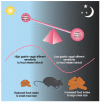Gastrointestinal Vagal Afferents and Food Intake: Relevance of Circadian Rhythms
- PMID: 33807524
- PMCID: PMC7998414
- DOI: 10.3390/nu13030844
Gastrointestinal Vagal Afferents and Food Intake: Relevance of Circadian Rhythms
Abstract
Gastrointestinal vagal afferents (VAs) play an important role in food intake regulation, providing the brain with information on the amount and nutrient composition of a meal. This is processed, eventually leading to meal termination. The response of gastric VAs, to food-related stimuli, is under circadian control and fluctuates depending on the time of day. These rhythms are highly correlated with meal size, with a nadir in VA sensitivity and increase in meal size during the dark phase and a peak in sensitivity and decrease in meal size during the light phase in mice. These rhythms are disrupted in diet-induced obesity and simulated shift work conditions and associated with disrupted food intake patterns. In diet-induced obesity the dampened responses during the light phase are not simply reversed by reverting back to a normal diet. However, time restricted feeding prevents loss of diurnal rhythms in VA signalling in high fat diet-fed mice and, therefore, provides a potential strategy to reset diurnal rhythms in VA signalling to a pre-obese phenotype. This review discusses the role of the circadian system in the regulation of gastrointestinal VA signals and the impact of factors, such as diet-induced obesity and shift work, on these rhythms.
Keywords: circadian; food intake; gastrointestinal tract; vagal afferents.
Conflict of interest statement
The author declares no conflict of interest. The NHMRC had no input in the content or the decision to write this review.
Figures



References
-
- Ma M.A., Morrison E.H. StatPearls. StatPearls Publishing; Treasure Island, FL, USA: 2019. Neuroanatomy, Nucleus Suprachiasmatic. - PubMed
Publication types
MeSH terms
Grants and funding
LinkOut - more resources
Full Text Sources
Other Literature Sources

